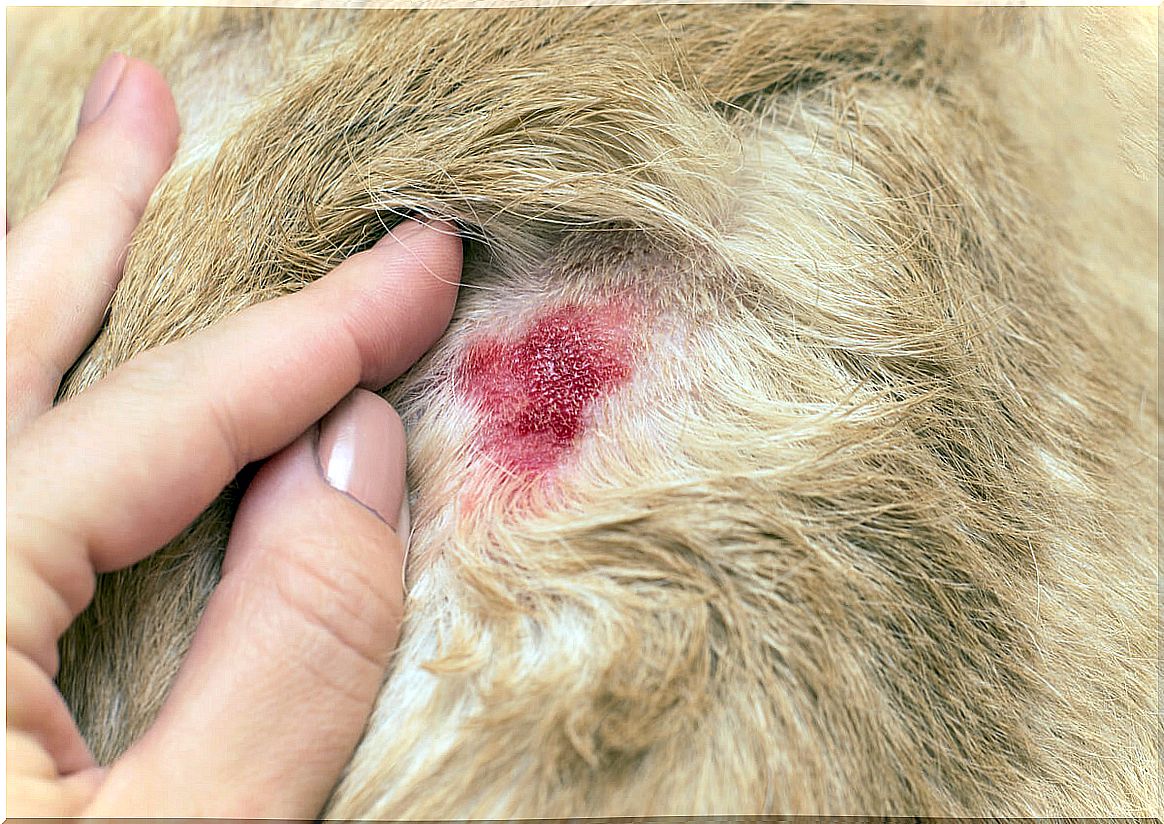Causes Of Skin Infections In Dogs

The skin is the largest organ in the body and protects living beings against infections and trauma, regulates water loss and body temperature, activates the synthesis of vitamin D and is responsible for the sense of touch. Therefore, skin infections in dogs must be addressed immediately.
The immune role of the skin is essential in mammals, since it is the first barrier against pathogens. For all these reasons, special care must be taken with the skin of pets: skin infections account for a large percentage of visits to the veterinary clinic.
What agents cause skin infections?
The skin is continuously exposed to the aggressions of the environment: heat, cold, solar radiation, water, dryness, chemical substances, injuries, wounds and a large number of infectious agents such as bacteria, fungi, yeasts, mites, parasites and viruses.
Pathogens are found in the environment or on the dog’s own skin. When a proliferation of this microbiota occurs or its infiltration through a lesion, a skin infection can occur, a fact that alters the balance of the skin. Here are some of the most common causes of this event.

Infections caused by bacteria
The resident microorganisms on the skin are bacteria and other agents that can grow in a healthy and normal epidermis. Some of the most common bacteria in dogs — and cats — are of the genus Micrococcus , Staphylococcus , Streptococcus, or Clostridium. This flora varies according to the body area and the skin layer.
Staphilococcus intermedius is one of the bacteria most involved in cases of canine skin infections. This organism naturally resides in the nostrils, oropharynx, and around the anus of dogs. Unfortunately, it is also often present in many cases of bacterial pyoderma.
Superficial skin infections in dogs can be classified as follows:
- Impetigo : caused by Staphylococcus , this disorder is characterized by alopecic areas with pustules that end up crusting the skin of the animal. It is common in young dogs.
- Mucocutaneous pyoderma : its signs are depigmentation, erythema, edema and / or crusting on the skin.
- Superficial folliculitis : it is very common in dogs. It is also caused by Staphylococcus intermedius and occurs at the upper level of the hair follicle.
Deep pyodermas are serious bacterial infections that affect deeper tissues. They can be the result of a superficial or poorly treated infection. Anaerobic bacteria are the main agents of these skin infections and can affect large areas of the body or be localized.
The former are associated with an underlying disease, responsible for an alteration of the immune system. Therefore, in addition to treating the infection, the underlying debilitating disease must be addressed in order to fully cure the dog.
Localized deep infections are usually caused by trauma , such as a bite or a foreign body that evolves into an infection in a specific area of the dog’s body.
Skin infections caused by fungi and yeasts
Lesions caused by fungi on the skin are very characteristic. They can be recognized by producing alopecic, circular, scaly areas and reddened edges that appear anywhere on the body.
Although any animal can suffer from a fungal infection, there are more vulnerable groups. Among them, we find the following:
- Kittens and Puppies : Young can become infested through close contact with the mother.
- Older animals.
- Animals suffering from an immunosuppressive disease.
Contagion with stray animals collected is also typical. Before introducing a new pet at home, you must deworm it correctly and keep it isolated from the rest of the household members for a while. Remember also that high temperatures and high humidity facilitate the proliferation of fungi.
Dermatophytosis or, as it is better known, ringworm, is a skin infection caused by the fungi of the genus Microsporum, Trichophyton and Epidermophyton .
Malassezia is a yeast found in the ear canals, anal sacs, and mucocutaneous junctions of the dog. Under normal conditions, its levels are not high enough to cause an infection, but in certain cases – such as a lowering of defenses – it can proliferate and generate a pathology.
This infection causes severe itching, erythema, and greasy exudate with scaling and crusting on the ears, lips, muzzle, legs, neck, armpit, belly, and anal area.
Skin infections caused by parasites
Fleas, lice and ticks can cause skin infections or even, in more sensitive dogs, cause strong allergic reactions. Microscopic parasites like mites can also cause infections.
The most common mange in dogs is caused by the Sarcoptes scabiei mite and is highly contagious. The affected dog feels a very intense itch, especially in the area of the ears, the face, the armpits and the belly area. Papules, scabs, excoriations and alopecia appear due to intense scratching.

These are the main causes of skin infections in dogs, if you notice that your dog scratches too much or has some type of skin lesion, you should go to the vet so that he can detect the cause and establish the correct treatment.









